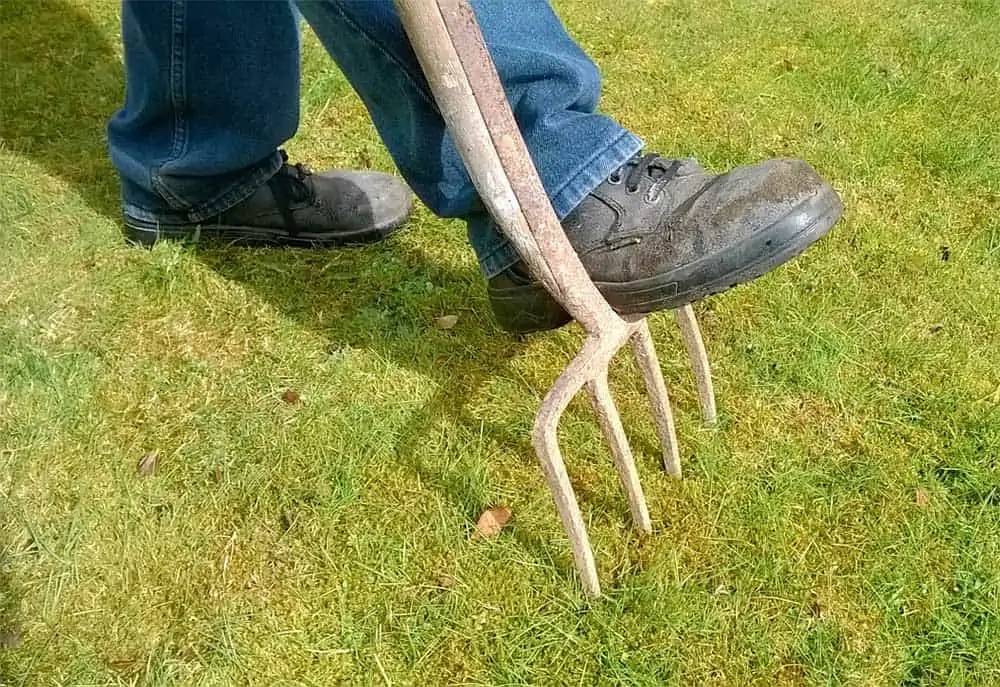We all know that the key to luscious, thick, and healthy lawns is regular care and maintenance. Whether it’s a good fertilizer, regular cuttings, and hydrating, we often find ourselves wondering about aerating our lawns.
Is it going to be healthy for my lawn? Are there any risks? The last thing we want to do is damage our lawns, leaving them with lots of uneven holes! But before you descend into panic, let’s take a closer look at aerating your lawn.

No longer just for professionals, you can aerate your lawn, and here is how!
Table of Contents
How do I aerate my lawn?
Typically, there are three types of aerating equipment ranging from small manual versions to larger tractor style or pull-behind machinery. You can use these machines yourself or hire a professional, depending on your budget.
Before you begin aerating your lawn, some prep work is needed. One or two days before aeration, thoroughly water your lawn; about 1-inch of water to grass will be ideal depending on its length. Watering the lawn will help the aerator penetrate the soil and pull it out easily.
Aerating your lawn will feel a lot like mowing your lawn. You will work back and forth across your lawn, focusing on any problem areas like pet runs or any baseball diamonds. The secret to perfect aeration is passing in different directions! This ensures optimal coverage and benefits.
Once aerated, leave the soil cores on the ground for them to decompose. You can rake them into piles and compost them if you would like to, although it is not necessary. You can then sprinkle compost, sand, or peat moss over the lawn to fill in the holes.
If you want to apply grass seed and fertilizer to your lawns, now is the time to do so, as the soil will absorb them easier compared to before aeration!
Let’s take a closer look at the type of aerators available to help you choose the best one for you and your lawn!
Spike aerators
Spike aerators feature a soli spike-like tine that will poke a hole down into the soil. You can get these as ‘sandals’ which can be strapped to your feet, allowing you to aerate your lawn as you work in the garden.
Spike aerators are fantastic for a small scale, but they risk pressing soil together around the holes, worsening any compaction.
Slicing aerators
Slicing aerators feature rotating blades that cut or slice through the grass, thatch, and down into the soil. Like spike aerators, slicing aerators leave the soil in the ground, but they create pathways for air, water, and nutrients without causing the compaction issues we see with spike aerators.
Core or plug aerators
Core or plug aerators are the preferred methods by lawn professionals. These aerators use rows of hollow lines that remove plugs of soil from your lawn, placing them on top where they can break down.
The size of the plugs and holes can vary in width and depth depending on the machine used. You can get the best one to suit your lawn and its needs! You are also less likely to have a compaction problem with a core or plug aerator.
Is aeration good for your lawn?
Yes, aeration will allow your lawn to thrive with health and happiness! There are many benefits of lawn aeration, and we will walk you through the main benefits now! Aeration improves turf health, providing greater access to air, water, and fertilizer to promote growth.
Aeration also reduces thatch build-up, relieves soil compaction, and prepares grass for winter dormancy and green spring. Aeration before fertilizing allows the nutrients to soak in effectively and provides it with nutrients to power it through the winter period.
Aerating your lawn also reduces water runoff and puddling, reducing stagnant water that can be problematic for lawns. Adding lime or sulfur after aeration will promote the change of pH deeper into the soil, allowing for deeper penetration of nutrients and healthier grass.
It can also help with seed cultivations, ensuring a protected environment for your seeds to thrive in.
Should I pick up plugs after aerating?
No. You can leave soil plugs on the lawn after aeration. The plugs will decompose and filter back into the holes left by your aeration machine, depending on their size. Remember, if you have used a spike aeration machine with small holes, you will need to be on the lookout for compaction.
Often, your lawn mower will break up plugs up the next time you mow your lawn. They will generally work back into the soil within two to three weeks, leaving you with little to no clean-up!
Letting the plugs work back into the soil reduces waste and ensures that nutrients are not lost by aeration; just be mindful that the soil can sometimes cause compaction issues.

